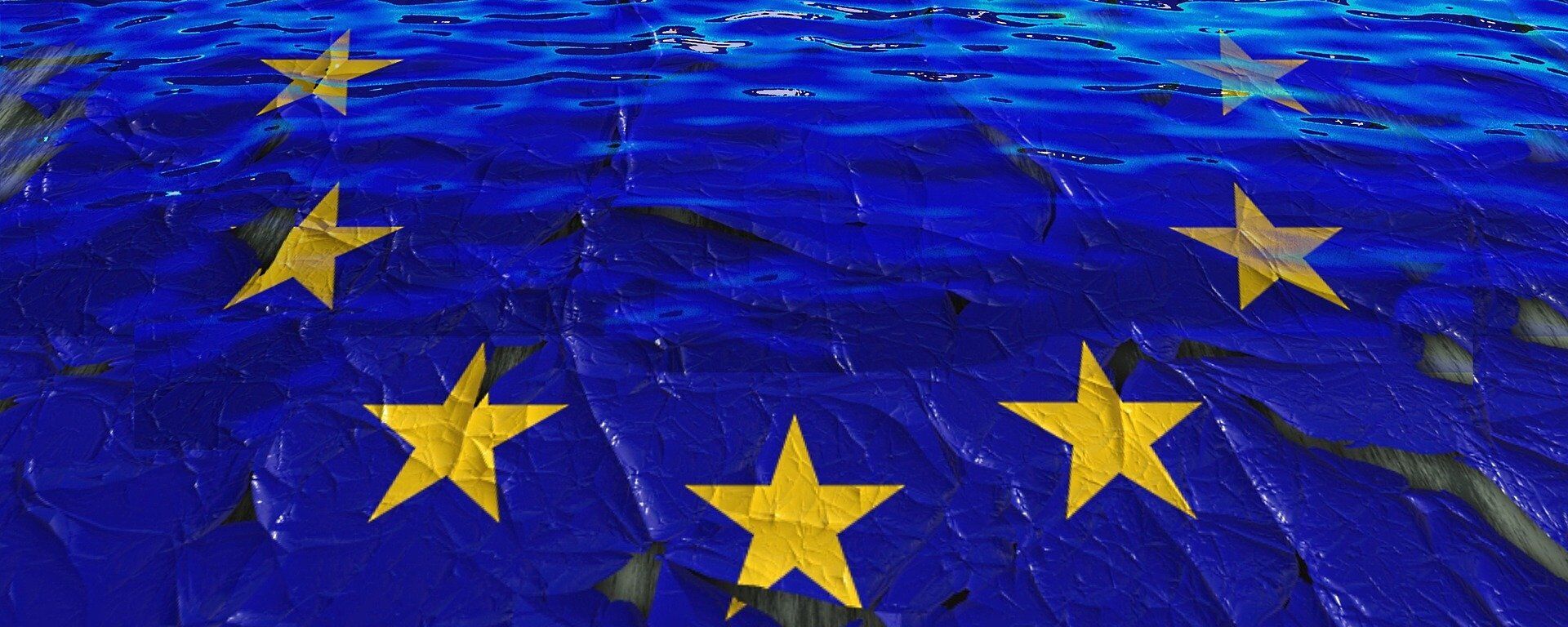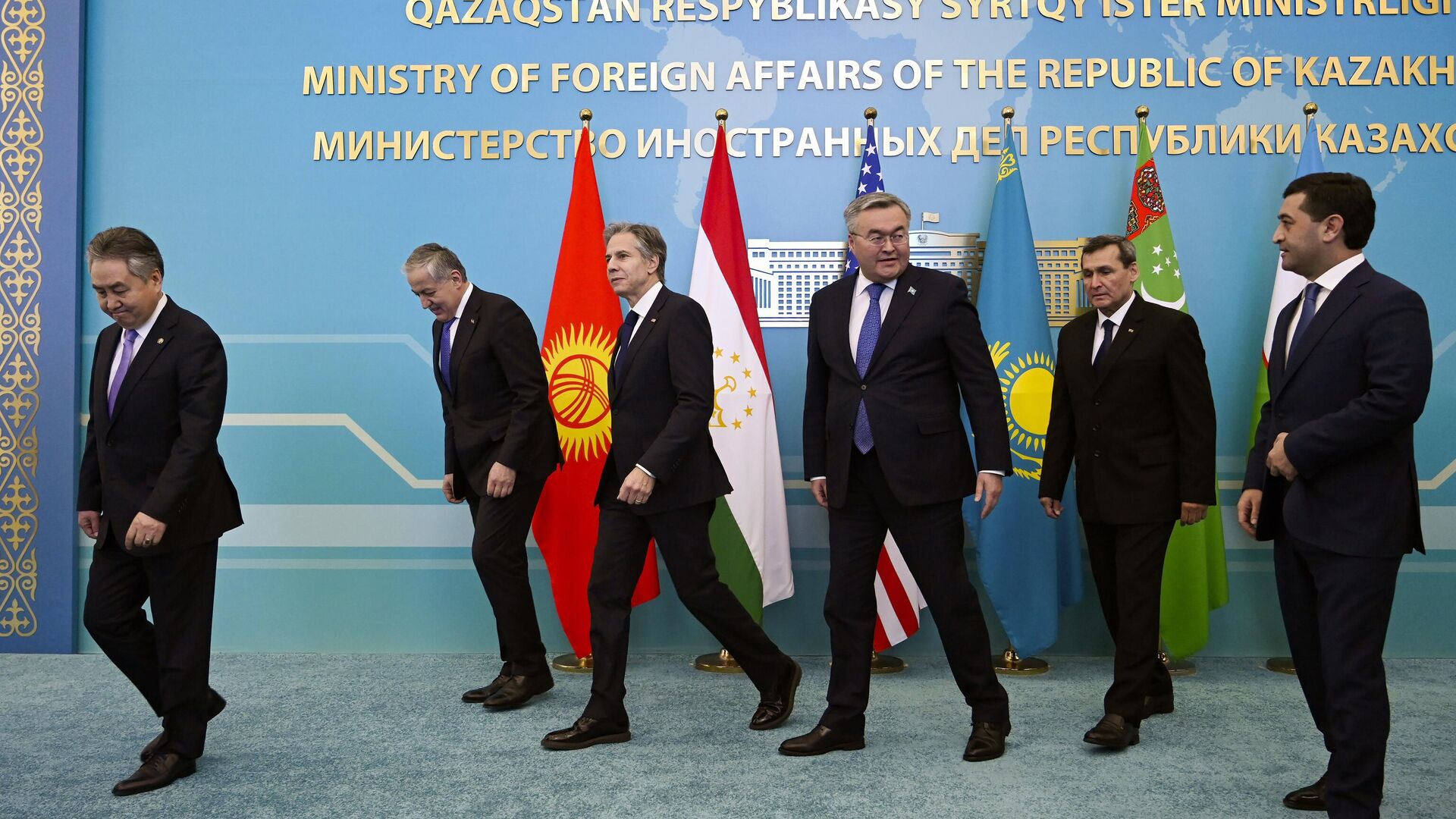https://sputnikglobe.com/20230301/blinkens-central-asia-trip-was-meant-to-open-a-second-front-against-russia-why-it-failed-1107915046.html
Blinken's Central Asia Trip Was Meant to Open a 'Second Front' Against Russia: Why It Failed
Blinken's Central Asia Trip Was Meant to Open a 'Second Front' Against Russia: Why It Failed
Sputnik International
The US secretary of state has completed a two-day tour of Central Asia, traveling to Kazakhstan and Uzbekistan and meeting with the Kazakh, Uzbek, Kyrgyz, Tajik and Turkmeni foreign ministers in Astana. What was the point of the trip? And why are US options for challenging Russia and China in the region so dim? Sputnik explains.
2023-03-01T19:31+0000
2023-03-01T19:31+0000
2023-03-01T19:49+0000
analysis
antony blinken
us
central asia
kazakhstan
uzbekistan
visit
trip
purpose
https://cdn1.img.sputnikglobe.com/img/07e7/03/01/1107914879_0:160:3073:1888_1920x0_80_0_0_b995ffa5ec2f7177acc81fa9c1a312fb.jpg
Secretary of State Antony Blinken wrapped up a visit to Central Asia on Wednesday, announcing a $25 million ‘aid’ carrot meant to push countries to diversify trade away from Russia, reiterating US support for “sovereignty, independence and territorial integrity,” and threatening them with the sanctions stick by warning that Washington is “watching compliance” on anti-Russia sanctions “very closely.”“We’re very conscious of the spillover consequences of Russia’s aggression. We’re doing everything we can to minimize them, to mitigate them and create lots of different opportunities for partners here in Central Asia,” Blinken said during his meeting with Kazakh Foreign Minister Mukhtar Tileuberdi on Tuesday.Blinken also took a break from regional affairs to take a potshot at China, the other major partner of Central Asia besides Russia, accusing Beijing of trying to “have it both ways” by rolling out an Ukraine peace plan while simultaneously “continu[ing] to fuel the flames of” the “fire that Vladimir Putin started” by refusing to join Washington in its global effort to sanction Moscow into submission.Blinken’s travels took him to the Kazakh capital of Astana, and to Tashkent, capital of Uzbekistan.Why These Countries?“These two countries are key regional leaders in terms of their economic, raw materials, demographic, military-political and all other potential,” says Andrei Grozin, a veteran Central Asia expert at the Moscow-based institute of CIS Countries.The US strategy for Central Asia has revolved around Kazakhstan and Uzbekistan since at least the George W. Bush era, when American Eurasian affairs S. Frederick Starr posited that where the Uzbeks and the Kazakhs go, the rest of the region will follow, Grozin explained in an interview.“Tashkent,” for its part, “is interesting [to Washington] as the regional leader dominating in the demographic sense. About half of the 72-75 million population of Central Asia are citizens of the Republic of Uzbekistan,” Grozin said.Carrot and Stick“The purpose of Blinken’s trip is clear and is centered around the geopolitical circumstances which are currently being observed in the region,” says Dr. Stanislav Pritchin, a senior research fellow at the Center for Post-Soviet Studies at the Institute of World Economy and International Relations, a leading Moscow-based international relations-focused research center.“At the same time, outwardly, the West expresses its readiness to cooperate with the region, to develop some mythical projects which will ultimately allow Central Asian countries to feel more confident in their relations with Russia,” the observer said.The problem, according to the academic, is that since the closure of the last US military base in Central Asia in 2014 – when US forces returned the Manas airbase to Kyrgyz forces, is that Washington’s arguments urging less cooperation with Russia carry little practical weight. That’s because the West cannot promise the same kinds of economic opportunities, integration projects, or regional security structures.The US strategy of trying to “push Russia and China out of the region” is an “absolutely impossible and fantastical idea,” according to Pritchin, because the West simply cannot step into the latter two countries’ shoes by virtue of geographical and historical realities.“Russia and China mean trade – serving as the key trade partners of the countries of Central Asia. Russia and China mean education, social and economic stability, and labor migration,” Pritchin stressed. And there is nothing the US can do to challenge this state of affairs apart from immense investments of time and financial resources which Washington does not have.Grozin concurs, pointing out that neither during Blinken’s trip nor in State Department releases did Washington offer any kind of “large-scale projects” which might interest Central Asian countries or sway them away from its regional partners.The academic pointed to Central Asia’s ties to Russia by the sheer weight of economic ties ($9.3 billion in trade with Uzbekistan, $22.5 billion with Kazakhstan, $3 billion with Kyrgyzstan in 2022, and up to 4 million Central Asian migrant laborers working in Russia). “These people would either have to be sent to America, or offered some other markets and means of earning money. Millions of people out of work. Where would the US put them? And that’s just one little detail,” the observer emphasized.“We’re talking about established economic ties within the framework of global economic, continental systems which the Americans propose to simply abandon,” Grozin said.Grozin estimates rebuilding the established system would cost tens if not hundreds of billions of dollars, and many, many years. Furthermore, some geographic limitations are simply impossible to realign, given, for example, that Kazakhstan exports about 70 percent of its oil to world markets through Russia and the Caspian Pipeline Consortium.Controlled ChaosThe one constant of the US' 30-year strategy in Central Asia has been support for color revolutions, various NGOs associated with the Democracy Institute, USAID, George Soros’ Open Democracy Foundations and other affiliated structures. However, these tools have not only proven geographically limited (largely to Kazakhstan and Kyrgyzstan), but have failed to bring the expected fruits of bringing anti-Russian, anti-China governments to power and keeping them in power, according to Grozin.
https://sputnikglobe.com/20230224/kazakh-energy-firm-suggests-russias-gazprom-build-gas-pipeline-to-china-via-kazakhstan-1107780309.html
https://sputnikglobe.com/20230210/eu-seeking-access-to-central-asian-resources-to-replace-supplies-from-russia-moscow-says-1107323831.html
https://sputnikglobe.com/20221121/why-eus-plan-to-sideline-russia-and-china-in-central-asia-is-sad-joke-1104512055.html
https://sputnikglobe.com/20220829/cash-for-chaos-four-times-us-toppled-european--central-asian-governments-using-the-almighty-dollar-1100135800.html
central asia
kazakhstan
uzbekistan
Sputnik International
feedback@sputniknews.com
+74956456601
MIA „Rossiya Segodnya“
2023
News
en_EN
Sputnik International
feedback@sputniknews.com
+74956456601
MIA „Rossiya Segodnya“
Sputnik International
feedback@sputniknews.com
+74956456601
MIA „Rossiya Segodnya“
antony blinken, central asia, trip, visit, analysis, explanation, review
antony blinken, central asia, trip, visit, analysis, explanation, review
Blinken's Central Asia Trip Was Meant to Open a 'Second Front' Against Russia: Why It Failed
19:31 GMT 01.03.2023 (Updated: 19:49 GMT 01.03.2023) The US secretary of state has completed a two-day tour of Central Asia, traveling to Kazakhstan and Uzbekistan and meeting with the Kazakh, Uzbek, Kyrgyz, Tajik and Turkmeni foreign ministers in Astana. What was the point of the trip? And why are US options for challenging Russia and China in the region so dim? Sputnik explains.
Secretary of State Antony Blinken wrapped up a visit to Central Asia on Wednesday, announcing a
$25 million ‘aid’ carrot meant to push countries to diversify trade away from Russia, reiterating US support for “sovereignty, independence and territorial integrity,” and threatening them with the sanctions stick by warning that Washington is
“watching compliance” on anti-Russia sanctions “very closely.”“We’re very conscious of the spillover consequences of Russia’s aggression. We’re doing everything we can to minimize them, to mitigate them and create lots of different opportunities for partners here in Central Asia,” Blinken said during his meeting with Kazakh Foreign Minister Mukhtar Tileuberdi on Tuesday.
Blinken also took a break from regional affairs to take a potshot at China, the other major partner of Central Asia besides Russia,
accusing Beijing of trying to “have it both ways” by rolling out an Ukraine peace plan while simultaneously “continu[ing] to fuel the flames of” the “fire that Vladimir Putin started” by refusing to join Washington in its global effort to sanction Moscow into submission.
Blinken’s travels took him to the Kazakh capital of Astana, and to Tashkent, capital of Uzbekistan.
“These two countries are key regional leaders in terms of their economic, raw materials, demographic, military-political and all other potential,” says Andrei Grozin, a veteran Central Asia expert at the Moscow-based institute of CIS Countries.
The US strategy for Central Asia has revolved around Kazakhstan and Uzbekistan since at least the George W. Bush era, when American Eurasian affairs S. Frederick Starr posited that where the Uzbeks and the Kazakhs go, the rest of the region will follow, Grozin explained in an interview.
“Kazakhstan, after all, is the country that’s most plugged into the global economic system among the five Central Asian states through its raw materials exports, and in terms of the involvement of transnational corporations in projects in Kazakhstan, primarily in the production and transport of liquid hydrocarbons,” the observer noted.
“Tashkent,” for its part, “is interesting [to Washington] as the regional leader dominating in the demographic sense. About half of the 72-75 million population of Central Asia are citizens of the Republic of Uzbekistan,” Grozin said.

24 February 2023, 18:48 GMT
“The purpose of Blinken’s trip is clear and is centered around the geopolitical circumstances which are currently being observed in the region,” says Dr. Stanislav Pritchin, a senior research fellow at the Center for Post-Soviet Studies at the Institute of World Economy and International Relations, a leading Moscow-based international relations-focused research center.
“First and foremost there is the Ukrainian crisis, which creates excellent opportunities for Western countries to complicate Russia’s life through dialogue with Moscow’s other neighbors. Here, first of all, the strategy of the stick is used. That is, regional countries implicitly, under the guise of talk about cooperation and the importance of dialogue, are told that it’s important not to help Russia bypass sanctions, that it’s important to reduce cooperation with Russia, otherwise there will be secondary sanctions. This is the main trump card of Western countries,” Pritchin said in an interview.
“At the same time, outwardly, the West expresses its readiness to cooperate with the region, to develop some mythical projects which will ultimately allow Central Asian countries to feel more confident in their relations with Russia,” the observer said.
The problem, according to the academic, is that since the closure of the last US military base in Central Asia in 2014 – when US forces
returned the Manas airbase to Kyrgyz forces, is that Washington’s arguments urging less cooperation with Russia carry little practical weight. That’s because the West cannot promise the same kinds of economic opportunities, integration projects, or regional security structures.
The US strategy of trying to “push Russia and China out of the region” is an “absolutely impossible and fantastical idea,” according to Pritchin, because the West simply cannot step into the latter two countries’ shoes by virtue of geographical and historical realities.
“The West cannot be the guarantor of security. This was demonstrated perfectly by the events of January 2022, when the crisis in Kazakhstan was stopped only thanks to the participation of the Collective Security Treaty Organization and the political decision of the Russian leadership. The West cannot be [the prime] economic partner, because its economic presence is limited to a number of energy projects in western Kazakhstan which were implemented in the early 1990s,” the observer noted.
“Russia and China mean trade – serving as the key trade partners of the countries of Central Asia. Russia and China mean education, social and economic stability, and labor migration,” Pritchin stressed. And there is nothing the US can do to challenge this state of affairs apart from immense investments of time and financial resources which Washington does not have.
“Therefore, what we have here, of course, is mostly a political game with nothing behind it,” the scholar said, summing up Blinken's trip. Absent the ability to use its economic weight to force countries to change course, all that’s left for Washington is political pressure and rhetoric, including allegations of a lack of transparency, a lack of democracy, a lack of market mechanisms, “i.e. the same tools Western countries use in relation to all developing countries,” Pritchin noted.
Grozin concurs, pointing out that neither during Blinken’s trip nor in State Department releases did Washington offer any kind of “large-scale projects” which might interest Central Asian countries or sway them away from its regional partners.

10 February 2023, 15:34 GMT
The academic pointed to Central Asia’s ties to Russia by the sheer weight of economic ties ($9.3 billion in trade with Uzbekistan, $22.5 billion with Kazakhstan, $3 billion with Kyrgyzstan in 2022, and up to 4 million Central Asian migrant laborers working in Russia). “These people would either have to be sent to America, or offered some other markets and means of earning money. Millions of people out of work. Where would the US put them? And that’s just one little detail,” the observer emphasized.
“We’re talking about established economic ties within the framework of global economic, continental systems which the Americans propose to simply abandon,” Grozin said.
Grozin estimates rebuilding the established system would cost tens if not hundreds of billions of dollars, and many, many years. Furthermore, some geographic limitations are simply impossible to realign, given, for example, that Kazakhstan exports about 70 percent of its oil to world markets through Russia and the
Caspian Pipeline Consortium.
21 November 2022, 18:13 GMT
The one constant of the US' 30-year strategy in Central Asia has been support for color revolutions, various NGOs associated with the Democracy Institute, USAID, George Soros’ Open Democracy Foundations and other affiliated structures. However, these tools have not only proven geographically limited (largely to Kazakhstan and Kyrgyzstan), but have failed to bring the expected fruits of bringing anti-Russian, anti-China governments to power and keeping them in power, according to Grozin.
The US interest revolves around trying to create chaos in regions bordering Russia – the Southern Caucasus and Central Asia. “Attempts to draw Georgia into opening a ‘second front’ have stalled and nothing has come of them. So Blinken traveled to Central Asia. It’s obvious that the US won’t be able to tear these countries off from Russia. But if that’s not possible, at least some problems, some kind of tensions could be created to divert Russia’s attention and reduce its potential; if they’re lucky, maybe they’ll be able to ignite something again,” Grozin concluded.

29 August 2022, 18:22 GMT






